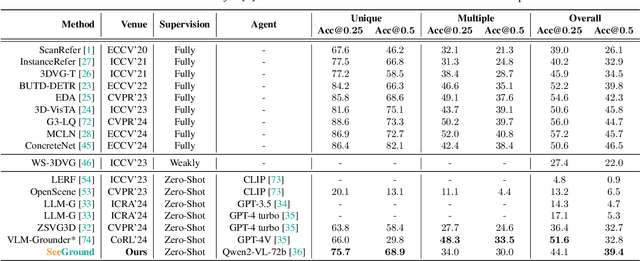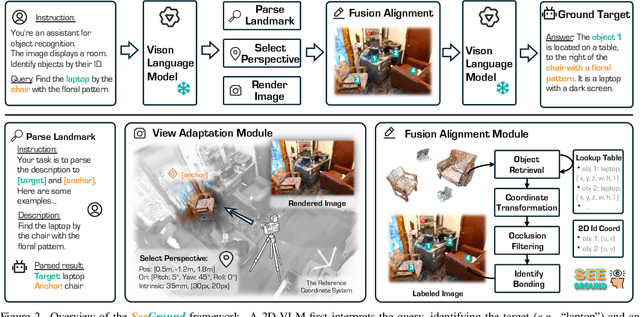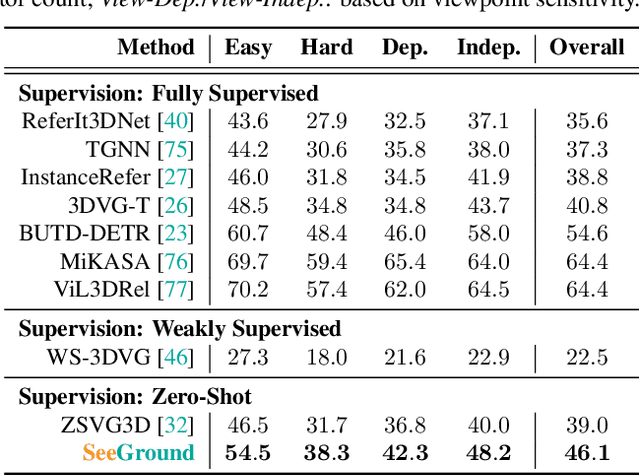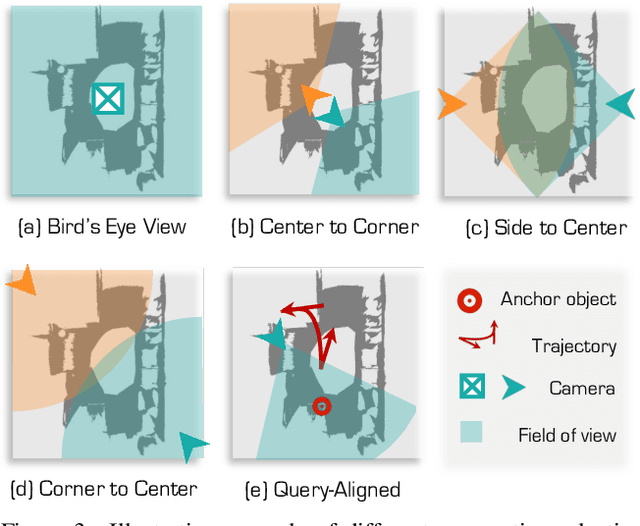Junwei Liang
From Watch to Imagine: Steering Long-horizon Manipulation via Human Demonstration and Future Envisionment
Sep 26, 2025Abstract:Generalizing to long-horizon manipulation tasks in a zero-shot setting remains a central challenge in robotics. Current multimodal foundation based approaches, despite their capabilities, typically fail to decompose high-level commands into executable action sequences from static visual input alone. To address this challenge, we introduce Super-Mimic, a hierarchical framework that enables zero-shot robotic imitation by directly inferring procedural intent from unscripted human demonstration videos. Our framework is composed of two sequential modules. First, a Human Intent Translator (HIT) parses the input video using multimodal reasoning to produce a sequence of language-grounded subtasks. These subtasks then condition a Future Dynamics Predictor (FDP), which employs a generative model that synthesizes a physically plausible video rollout for each step. The resulting visual trajectories are dynamics-aware, explicitly modeling crucial object interactions and contact points to guide the low-level controller. We validate this approach through extensive experiments on a suite of long-horizon manipulation tasks, where Super-Mimic significantly outperforms state-of-the-art zero-shot methods by over 20\%. These results establish that coupling video-driven intent parsing with prospective dynamics modeling is a highly effective strategy for developing general-purpose robotic systems.
End-to-End Humanoid Robot Safe and Comfortable Locomotion Policy
Aug 11, 2025Abstract:The deployment of humanoid robots in unstructured, human-centric environments requires navigation capabilities that extend beyond simple locomotion to include robust perception, provable safety, and socially aware behavior. Current reinforcement learning approaches are often limited by blind controllers that lack environmental awareness or by vision-based systems that fail to perceive complex 3D obstacles. In this work, we present an end-to-end locomotion policy that directly maps raw, spatio-temporal LiDAR point clouds to motor commands, enabling robust navigation in cluttered dynamic scenes. We formulate the control problem as a Constrained Markov Decision Process (CMDP) to formally separate safety from task objectives. Our key contribution is a novel methodology that translates the principles of Control Barrier Functions (CBFs) into costs within the CMDP, allowing a model-free Penalized Proximal Policy Optimization (P3O) to enforce safety constraints during training. Furthermore, we introduce a set of comfort-oriented rewards, grounded in human-robot interaction research, to promote motions that are smooth, predictable, and less intrusive. We demonstrate the efficacy of our framework through a successful sim-to-real transfer to a physical humanoid robot, which exhibits agile and safe navigation around both static and dynamic 3D obstacles.
Stairway to Success: Zero-Shot Floor-Aware Object-Goal Navigation via LLM-Driven Coarse-to-Fine Exploration
May 29, 2025Abstract:Object-Goal Navigation (OGN) remains challenging in real-world, multi-floor environments and under open-vocabulary object descriptions. We observe that most episodes in widely used benchmarks such as HM3D and MP3D involve multi-floor buildings, with many requiring explicit floor transitions. However, existing methods are often limited to single-floor settings or predefined object categories. To address these limitations, we tackle two key challenges: (1) efficient cross-level planning and (2) zero-shot object-goal navigation (ZS-OGN), where agents must interpret novel object descriptions without prior exposure. We propose ASCENT, a framework that combines a Multi-Floor Spatial Abstraction module for hierarchical semantic mapping and a Coarse-to-Fine Frontier Reasoning module leveraging Large Language Models (LLMs) for context-aware exploration, without requiring additional training on new object semantics or locomotion data. Our method outperforms state-of-the-art ZS-OGN approaches on HM3D and MP3D benchmarks while enabling efficient multi-floor navigation. We further validate its practicality through real-world deployment on a quadruped robot, achieving successful object exploration across unseen floors.
Zero-Shot 3D Visual Grounding from Vision-Language Models
May 28, 2025



Abstract:3D Visual Grounding (3DVG) seeks to locate target objects in 3D scenes using natural language descriptions, enabling downstream applications such as augmented reality and robotics. Existing approaches typically rely on labeled 3D data and predefined categories, limiting scalability to open-world settings. We present SeeGround, a zero-shot 3DVG framework that leverages 2D Vision-Language Models (VLMs) to bypass the need for 3D-specific training. To bridge the modality gap, we introduce a hybrid input format that pairs query-aligned rendered views with spatially enriched textual descriptions. Our framework incorporates two core components: a Perspective Adaptation Module that dynamically selects optimal viewpoints based on the query, and a Fusion Alignment Module that integrates visual and spatial signals to enhance localization precision. Extensive evaluations on ScanRefer and Nr3D confirm that SeeGround achieves substantial improvements over existing zero-shot baselines -- outperforming them by 7.7% and 7.1%, respectively -- and even rivals fully supervised alternatives, demonstrating strong generalization under challenging conditions.
Omni-Perception: Omnidirectional Collision Avoidance for Legged Locomotion in Dynamic Environments
May 25, 2025Abstract:Agile locomotion in complex 3D environments requires robust spatial awareness to safely avoid diverse obstacles such as aerial clutter, uneven terrain, and dynamic agents. Depth-based perception approaches often struggle with sensor noise, lighting variability, computational overhead from intermediate representations (e.g., elevation maps), and difficulties with non-planar obstacles, limiting performance in unstructured environments. In contrast, direct integration of LiDAR sensing into end-to-end learning for legged locomotion remains underexplored. We propose Omni-Perception, an end-to-end locomotion policy that achieves 3D spatial awareness and omnidirectional collision avoidance by directly processing raw LiDAR point clouds. At its core is PD-RiskNet (Proximal-Distal Risk-Aware Hierarchical Network), a novel perception module that interprets spatio-temporal LiDAR data for environmental risk assessment. To facilitate efficient policy learning, we develop a high-fidelity LiDAR simulation toolkit with realistic noise modeling and fast raycasting, compatible with platforms such as Isaac Gym, Genesis, and MuJoCo, enabling scalable training and effective sim-to-real transfer. Learning reactive control policies directly from raw LiDAR data enables the robot to navigate complex environments with static and dynamic obstacles more robustly than approaches relying on intermediate maps or limited sensing. We validate Omni-Perception through real-world experiments and extensive simulation, demonstrating strong omnidirectional avoidance capabilities and superior locomotion performance in highly dynamic environments. We will open-source our code and models.
SD-OVON: A Semantics-aware Dataset and Benchmark Generation Pipeline for Open-Vocabulary Object Navigation in Dynamic Scenes
May 24, 2025Abstract:We present the Semantics-aware Dataset and Benchmark Generation Pipeline for Open-vocabulary Object Navigation in Dynamic Scenes (SD-OVON). It utilizes pretraining multimodal foundation models to generate infinite unique photo-realistic scene variants that adhere to real-world semantics and daily commonsense for the training and the evaluation of navigation agents, accompanied with a plugin for generating object navigation task episodes compatible to the Habitat simulator. In addition, we offer two pre-generated object navigation task datasets, SD-OVON-3k and SD-OVON-10k, comprising respectively about 3k and 10k episodes of the open-vocabulary object navigation task, derived from the SD-OVON-Scenes dataset with 2.5k photo-realistic scans of real-world environments and the SD-OVON-Objects dataset with 0.9k manually inspected scanned and artist-created manipulatable object models. Unlike prior datasets limited to static environments, SD-OVON covers dynamic scenes and manipulatable objects, facilitating both real-to-sim and sim-to-real robotic applications. This approach enhances the realism of navigation tasks, the training and the evaluation of open-vocabulary object navigation agents in complex settings. To demonstrate the effectiveness of our pipeline and datasets, we propose two baselines and evaluate them along with state-of-the-art baselines on SD-OVON-3k. The datasets, benchmark and source code are publicly available.
Exploring the Limits of Vision-Language-Action Manipulations in Cross-task Generalization
May 21, 2025Abstract:The generalization capabilities of vision-language-action (VLA) models to unseen tasks are crucial to achieving general-purpose robotic manipulation in open-world settings. However, the cross-task generalization capabilities of existing VLA models remain significantly underexplored. To address this gap, we introduce AGNOSTOS, a novel simulation benchmark designed to rigorously evaluate cross-task zero-shot generalization in manipulation. AGNOSTOS comprises 23 unseen manipulation tasks for testing, distinct from common training task distributions, and incorporates two levels of generalization difficulty to assess robustness. Our systematic evaluation reveals that current VLA models, despite being trained on diverse datasets, struggle to generalize effectively to these unseen tasks. To overcome this limitation, we propose Cross-Task In-Context Manipulation (X-ICM), a method that conditions large language models (LLMs) on in-context demonstrations from seen tasks to predict action sequences for unseen tasks. Additionally, we introduce a dynamics-guided sample selection strategy that identifies relevant demonstrations by capturing cross-task dynamics. On AGNOSTOS, X-ICM significantly improves cross-task zero-shot generalization performance over leading VLAs. We believe AGNOSTOS and X-ICM will serve as valuable tools for advancing general-purpose robotic manipulation.
GLOVER++: Unleashing the Potential of Affordance Learning from Human Behaviors for Robotic Manipulation
May 17, 2025Abstract:Learning manipulation skills from human demonstration videos offers a promising path toward generalizable and interpretable robotic intelligence-particularly through the lens of actionable affordances. However, transferring such knowledge remains challenging due to: 1) a lack of large-scale datasets with precise affordance annotations, and 2) insufficient exploration of affordances in diverse manipulation contexts. To address these gaps, we introduce HOVA-500K, a large-scale, affordance-annotated dataset comprising 500,000 images across 1,726 object categories and 675 actions. We also release a standardized benchmarking suite for multi-modal affordance reasoning. Built upon HOVA-500K, we present GLOVER++, a global-to-local affordance training framework that effectively transfers actionable affordance knowledge from human demonstrations to downstream open-vocabulary reasoning tasks. GLOVER++ achieves state-of-the-art results on the HOVA-500K benchmark and demonstrates strong generalization across diverse downstream robotic manipulation tasks. By explicitly modeling actionable affordances, GLOVER++ facilitates robust transfer across scenes, modalities, and tasks. We hope that HOVA-500K and the GLOVER++ framework will serve as valuable resources for bridging the gap between human demonstrations and robotic manipulation capabilities.
GaussianProperty: Integrating Physical Properties to 3D Gaussians with LMMs
Dec 15, 2024Abstract:Estimating physical properties for visual data is a crucial task in computer vision, graphics, and robotics, underpinning applications such as augmented reality, physical simulation, and robotic grasping. However, this area remains under-explored due to the inherent ambiguities in physical property estimation. To address these challenges, we introduce GaussianProperty, a training-free framework that assigns physical properties of materials to 3D Gaussians. Specifically, we integrate the segmentation capability of SAM with the recognition capability of GPT-4V(ision) to formulate a global-local physical property reasoning module for 2D images. Then we project the physical properties from multi-view 2D images to 3D Gaussians using a voting strategy. We demonstrate that 3D Gaussians with physical property annotations enable applications in physics-based dynamic simulation and robotic grasping. For physics-based dynamic simulation, we leverage the Material Point Method (MPM) for realistic dynamic simulation. For robot grasping, we develop a grasping force prediction strategy that estimates a safe force range required for object grasping based on the estimated physical properties. Extensive experiments on material segmentation, physics-based dynamic simulation, and robotic grasping validate the effectiveness of our proposed method, highlighting its crucial role in understanding physical properties from visual data. Online demo, code, more cases and annotated datasets are available on \href{https://Gaussian-Property.github.io}{this https URL}.
SeeGround: See and Ground for Zero-Shot Open-Vocabulary 3D Visual Grounding
Dec 05, 2024



Abstract:3D Visual Grounding (3DVG) aims to locate objects in 3D scenes based on textual descriptions, which is essential for applications like augmented reality and robotics. Traditional 3DVG approaches rely on annotated 3D datasets and predefined object categories, limiting scalability and adaptability. To overcome these limitations, we introduce SeeGround, a zero-shot 3DVG framework leveraging 2D Vision-Language Models (VLMs) trained on large-scale 2D data. We propose to represent 3D scenes as a hybrid of query-aligned rendered images and spatially enriched text descriptions, bridging the gap between 3D data and 2D-VLMs input formats. We propose two modules: the Perspective Adaptation Module, which dynamically selects viewpoints for query-relevant image rendering, and the Fusion Alignment Module, which integrates 2D images with 3D spatial descriptions to enhance object localization. Extensive experiments on ScanRefer and Nr3D demonstrate that our approach outperforms existing zero-shot methods by large margins. Notably, we exceed weakly supervised methods and rival some fully supervised ones, outperforming previous SOTA by 7.7% on ScanRefer and 7.1% on Nr3D, showcasing its effectiveness.
 Add to Chrome
Add to Chrome Add to Firefox
Add to Firefox Add to Edge
Add to Edge